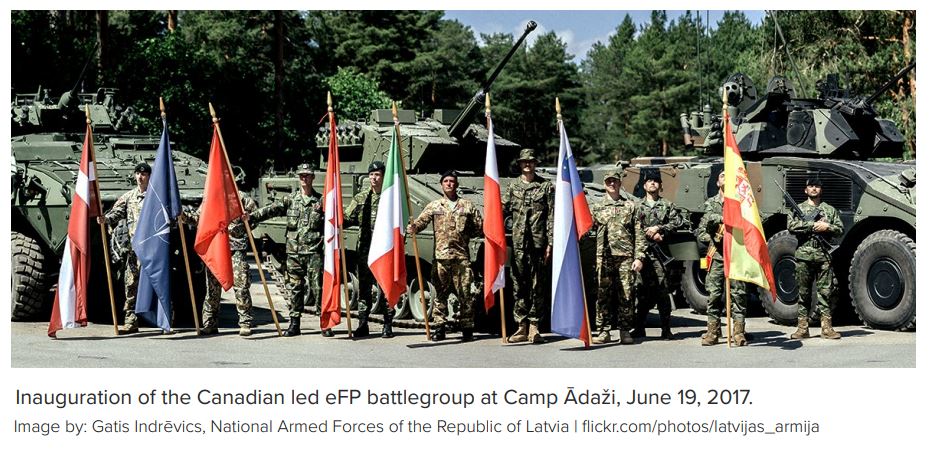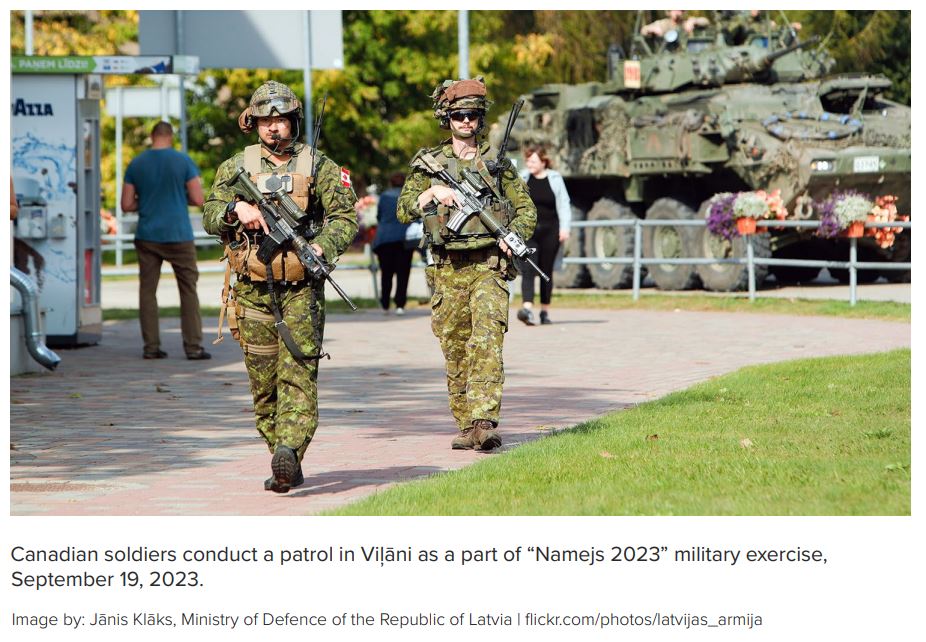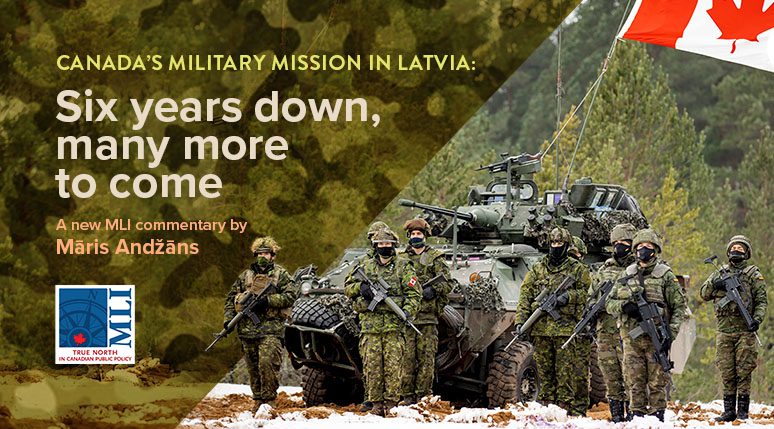By Māris Andžāns
December 20, 2023
It has been more than six years since Canada assumed leadership of NATO’s enhanced Forward Presence (eFP) mission in Latvia. So far, the mission has been a success, and both NATO and Latvia greatly appreciate Canada’s role. Canada’s military is expected to remain in Latvia for a long time so it has the opportunity to take on an even deeper and broader commitment to its role in the country.
The value of Canada’s military to Latvia
Latvia joined NATO in 2004, more than five decades after the foundation of the alliance. Becoming part of the alliance was one of the two top priorities of Latvia’s foreign and defence policy after the country regained its independence from the Soviet Union in 1991. Its other main aim was to become a member of the European Union. The main driving force behind these goals was to ensure that Latvia could return to the West and distance itself from Russia.
However, by 2004 NATO had changed. At the forefront of its agenda was not the collective defence of the countries in the alliance, but the fight against terrorism. Russia portrayed itself as a partner in this endeavour, and NATO treated Russia as a partner rather than a foe. On the one hand, Russia’s weakness and because it was then on good terms with NATO served to ease Latvia’s path to membership in the alliance. Russia objected to NATO’s expansion eastwards, but at that time had no means to stop it. On the other hand, the seemingly benign NATO-Russia relations led the alliance to be complacent about its collective defence.
A decade later in 2014 when Russia occupied and annexed Ukraine’s Crimea and started the war in Eastern Ukraine, NATO found itself with virtually no allied military presence in Latvia aside from the Baltic Air Policing mission that conducted flights from Lithuania (NATO 2023a) and periodic, mostly low-profile military exercises in which other NATO allies participated. Up to that point, stationing allied troops in Latvia was almost taboo. The Allies were reluctant to irritate and provoke Russia with any military deployment near the latter’s borders. Anyway, NATO felt that risks from Russia were not particularly high, despite its 2008 assault on Georgia.
This changed dramatically in 2014. In the spring of that year, following Russia’s aggression against Ukraine, the United States was the first to deploy a company-sized unit to Latvia (Latvia, Ministry of Defence 2023a). American rotations continue to this day as a part of Operation Atlantic Resolve (U.S. Army Europe and Africa 2023). However, it took the 2014 Wales (NATO 2014) and 2016 Warsaw (NATO 2016) summits for NATO to agree on the eFP battlegroups in all three Baltic states and Poland (NATO 2023b). In June 2017, the Canadian-led battlegroup in Latvia was inaugurated (Latvia, Ministry of Defence 2023b). This was a watershed moment in Latvia’s history: NATO’s collective defence clause was finally being backed up by allied boots on the ground. This was both a symbolic and practical step, reassuring Latvia and deterring Russia. Latvia could be confident that it was finally a fully fledged member state of NATO – not just a member on paper (Andžāns and Romanovs 2018).
In the six years since 2017, Latvia’s politicians and officials couldn’t have been clearer about on how much they and the country have appreciated Canada’s contribution to Latvia’s defence. Meanwhile, the quest for a broader and permanent NATO troop presence has been a growing priority for Latvia. One outcome from Russia’s full-scale war against Ukraine has been NATO’s decision at the 2022 Madrid Summit (NATO 2022) to expand the battalionsized eFP battlegroup in Latvia to a brigade-sized unit.
Latvia welcomes Canada
It is very apparent that Latvian state institutions greatly appreciate Canada’s military role in the country. This is confirmed both in the recently approved State Defence Concept (Saeima 2023a) and the National Security Concept (Saeima 2023b) documents. But political elites are not the only ones welcoming Canadian support.
As recent sociological surveys attest, Canada and its military enjoy a largely positive image in Latvia. Latvians rank Canada among the top 10 friendliest countries, according to two polls conducted in 2022. (On the contrary, Russia and Belarus were rated first and second, respectively, on the list of least friendly nations) (Andžāns 2023a, 340). In fact, Canada is perceived even more positively than fellow European allies Germany and France. Earlier poll data suggest that the most common associations Latvians have for Canada are ice hockey, welfare, maple leaf (and maple syrup), nature, and Canadian military support (SKDS 2016, 51).
Most of Latvia’s population also perceives Canada’s soldiers as professional and friendly, with approximately 45 percent and 20 percent of respondents saying so, respectively, in another 2022 poll (Banka and Bussmann 2024). The positive image is also due to Canadian troops taking care to avoid irritating incidents and to Canadian diplomats and soldiers alike undertaking active public diplomacy efforts. Disinformation campaigns against the Canadian troops, presumably conducted and/or instigated by Russia, have not succeeded. (For example, some disinformation activities linked Canadian troops to spreading the coronavirus. See, for example, Leuprecht, Moens, and Lanoszka (2020, 49)).

Measured among Latvian speakers only, views towards Canada are even more favourable. Both above-discussed polls reveal this. The less favourable views among Russian speakers are not indicative of any bad behaviour by Canada’s troops in Latvia. Generally, Russian speakers (which is definitely not a homogenous group) tend to be more cautious about most Western countries. There are many reasons for this, including a distinct historical memory, their higher affinity for Russia, and this group’s broader exposure to Russia’s information space.
The value of the mission for Canada
Latvia was the last of four countries to be assigned a framework nation that would take on the eFP. It is widely believed that Canada was reluctant to do so, but agreed to take charge of the battlegroup in Latvia after pressure from the United States (see e.g., Leuprecht, Moens, and Lanoszka 2020, 47; Leuprecht, Sokolsky, and Derow 2019, 167). Whatever the reasons, it has played out well for Canada, both politically and militarily.
First, with this mission, Canada is at the forefront of promoting peace and the rules-based international order. Rather than contributing to the mission with vague expressions of support or by providing less visible, behind-the-scenes assistance, leading the eFP has been a very practical way for Canada to defend the values that have traditionally guided its foreign and defence policy.
Second, this mission somewhat alleviates criticism from Canada’s allies that it has failed to reach a spending target of 2 percent of its gross domestic product (GDP) on defence. By taking on the leadership of the eFP, Canada has placed itself among the leaders in NATO who are deterring aggression against the allies. However, Latvia’s (and NATO’s) appreciation and approval should not make Canada complacent, but rather motivate it to increase its defence spending.
Third, there are many gains for Canada’s armed forces from taking on this mission. Despite Russia’s belligerence this is still a low-risk mission, particularly compared to other missions in conflict regions. At the same time, Latvia’s environment is providing Canadian soldiers with opportunities to improve their skills and knowledge in multiple ways.
After years focused on fighting insurgents following 9/11, the mission in Latvia is allowing the Canadian Armed Forces to refit their skills to take on the classical tasks of armed forces. Canadian soldiers consistently participate in training and exercises, including conducting live fire exercises on the military training grounds in all weather conditions. No less importantly, this is being done in a multinational environment, thus enabling Canada to practice and improve its interoperability with other armed forces in a real-life environment.
Latvia’s main military base, Camp Ādaži, and its accompanying training ground are becoming crowded, despite its significant expansion in recent years. Consequently, Latvia is developing a new training area, Sēlija (Selonia) (Latvia, Ministry of Defence 2023c). It will offer even more space and more training facilities and opportunities for Canadian troops, as it will be nearly double the size of the current Ādaži training area. Meanwhile, Canadian troops are also taking part in exercises outside military training areas. For example, Canadian armoured personnel carriers and troops conducted patrols in Latvian cities in September 2023 (Sargs.lv 2023).
No one should underestimate the amount of ability and experience that is required to lead the most multinational of all current NATO eFP battlegroups. The eFP battlegroup in Latvia is NATO’s most multinational battlegroup ever under the brigade level (Leuprecht, Moens, and Lanoszka 2020, 48). Canada oversees and manages the entire group, which includes personnel from Albania, the Czech Republic, Iceland, Italy, Montenegro, North Macedonia, Poland, Slovakia, Slovenia, and Spain (NATO 2023b). Though all are NATO members, each nation has its own way of doing things, and its own equipment, making it both a challenge and an opportunity for Canada to run and lead such a complex organization.

More space for more Canada in Latvia
Canada presently has around 1,000 soldiers in Latvia, making it Canada’s largest current international military deployment – and this number will continue to grow. By 2026, Canada will deploy up to 2,200 soldiers to Latvia (Canada, National Defence 2023). It is almost certain that Canada’s mission in the country will last at least a decade. Meanwhile, Latvia will hope and lobby for it to be longer than that.
However, the goals and troop numbers set for 2026 should be treated not as a ceiling, but a minimum. It is worth noting that Germany, which leads the Lithuanian eFP, has announced that it will deploy 4,000 soldiers to Lithuania by 2026 (Germany, Federal Ministry of Defence 2023). Given Germany’s complex historical legacy and the state of its armed forces, the German commitment is astounding (Andžāns 2023b). Germany is setting an example that Canada could follow.
While Canada is broadening the presence of its land forces in Latvia, it should also consider accompanying them with air and maritime assets. It is true that a Canadian warship is a part of the Standing NATO Mine Countermeasures Group 1, and Canadian aircraft have been periodically deployed to NATO’s eastern flank (Canada, National Defence 2023). Nevertheless, both the Port of Liepāja in western Latvia and the Lielvārde Air Base in the heart of the country (Latvia, National Armed Forces 2023a) could serve as outposts for a Canadian maritime and air presence. Such a commitment would further reassure Latvia and other NATO allies and would enable the Canadian forces deployed to Latvia to strengthen and train in combined arms operations. It could also ease the demand for Canada to be involved in potential crises in the surrounding regions.
Meanwhile, there is also some room for improvement with the currently deployed troops. One of the issues often mentioned is that most Canadian soldiers serve relatively brief six-month rotations in Latvia. Longer rotations, say at least nine months, would provide more benefits to the Canadian troops, the host nation, and other eFP nations. Because the current term is short, after allowing for settling in time and preparation for departure, the deployment is too brief for the incoming troops to enjoy the full spectrum of training and exercise activities.
Another area for improvement is in the Canadian-led eFP’s integration with the German-led eFP in Lithuania and the British-led eFP in Estonia. All three battlegroups should have equivalent capabilities to ensure that the chain of defence and deterrence is robust. Also, Canada and Latvia should give attention to fostering the interoperability of their equipment and, where possible, equipment from other eFP nations. This task is arguably complicated given each NATO ally’s different and complex equipment procurement procedures. But the enhanced interoperability of Canadian and Latvian equipment would be a good start.
Similarly, a further area for improvement lies in cooperation between the military industries of both countries and in reciprocal and common procurement of equipment. The Federation of Security and Defence Industries of Latvia (2023) celebrated its 10-year anniversary this year (Andžāns 2023c). The Latvian military industry received a boost in the past few years after the risks to national defence became more profound, and Latvia has increased its defence spending considerably (in 2023 it will be approximately 2.25 percent of GDP (Latvia, Ministry of Defence 2023d)). The spending goal for 2027 is even higher, at 3 percent of GDP (Latvia, Cabinet of Ministers 2023, 1). While currently the best-known Latvian-made military product is the Finnish company Patria’s 6×6 armoured personnel carrier (Sargs.lv 2021), the number of home-grown products is growing and includes unmanned ground, air, and sea surface vehicle projects (Brasa Defence Systems 2023; Atlas Aerospace 2022; Latvia, Ministry of Defence 2020).
Finally, Latvia and Canada should explore the possibility of integrating their forces for future international peacekeeping missions. Both nations could develop an integrated peacekeeping unit that could train and perhaps be deployed together.
Māris Andžāns, PhD, is the Director of the Center for Geopolitical Studies Riga. He is also an Associate Professor at Riga Stradins University.
References
Andžāns, Māris, and Uģis Romanovs. 2018. “NATO Enhanced Forward Presence in Latvia – A Historic Confirmation of the Reliability of Article 5 of the North Atlantic Treaty.” In Andris Sprūds and Ilvija Bruģe (eds.), Latvian Foreign and Security Policy. Yearbook 2018 (Latvian Institute of International Affairs): 66-77. Available at https://liia.lv/en/publications/latvian-foreign-and-security-policy-yearbook-2018-669?get_file=2.
Andžāns, Māris. 2023a. “Amity and Enmity in Regional Security Complexes: Public and Official Perceptions in Latvia after Russia’s Invasion of Ukraine.” Canadian Foreign Policy Journal 29, 3: 332-351. Available at https://www.tandfonline.com/doi/abs/10.1080/11926422.2023.2242971 [paywall].
Andžāns, Māris. 2023b. “Doubling Down on the Baltics.” Internationale Politik Quarterly (August 9). Available at https://ip-quarterly.com/en/doubling-down-baltics.
Andžāns, Māris. 2023c. “Latvia’s Military Industry Marks its First Decade.” Baltic Bulletin (May 31). Foreign Policy Research Institute. Available at https://www.fpri.org/article/2023/05/latvias-military-industry-marks-its-first-decade/.
Atlas Aerospace. 2022. Web site home page. Atlas Aerospace. Available at https://www.atlasuas.com.
Banka, Andris, and Margit Bussmann. 2024 (forthcoming). “‘Canada Is a Big Deal Here’: The eFP Battlegroup and Host Nation Public Opinion.” International Journal 79, 2.
Brasa Defence Systems. 2023. “Military Personnel Support System Natrix.” Brasa Defence Systems. Available at https://www.brasa.lv/en/Future-combat-systems.
Canada, National Defence. 2023. Operation REASSURANCE. Government of Canada. Available at https://www.canada.ca/en/department-national-defence/services/operations/military-operations/current-operations/operation-reassurance.html.
Federation of Security and Defence Industries of Latvia. 2023. Web site home page. Federation of Security and Defence Industries of Latvia. Available at https://federacija.lv/en.
Germany, Federal Ministry of Defence. 2023. “German Military Commitment to Lithuania.” Government of Germany (July 10). Available at https://www.bmvg.de/en/news/german-military-commitment-to-lithuania-5628002.
Latvia, Cabinet of Ministers. 2023. “Deklarācija par Evikas Siliņas vadītā Ministru kabineta iecerēto darbību 2023. gada 15. septembrī” [Declaration on the Cabinet of Ministers led by Evika Siliņa, September 15, 2023]. Government of Latvia (September 15). Available at https://www.mk.gov.lv/lv/media/16704/download?attachment.
Latvia, Ministry of Defence. 2020. “Aizsardzības ministrija deviņiem Latvijas uzņēmumiem piešķir grantus inovatīvu produktu izstrādei.” [Ministry of Defence allocates grants for nine Latvian companies to develop innovative products]. Government of Latvia (December 28). Available at https://www.mod.gov.lv/lv/zinas/aizsardzibas-ministrija-deviniem-latvijas-uznemumiem-pieskir-grantus-inovativu-produktu.
Latvia, Ministry of Defence. 2023a. “Strategic partner – USA.” Government of Latvia. Available at https://www.mod.gov.lv/en/nozares-politika/international-and-regional-cooperation/international-cooperation/strategic-partner.
Latvia, Ministry of Defence. 2023b. “Canada: Framework Nation of eFP Battle Group in Latvia.” Government of Latvia. Available at https://www.mod.gov.lv/en/nozares-politika/international-and-regional-cooperation/international-cooperation/canada-framework.
Latvia, Ministry of Defence. 2023c. “Information about Selonia Military Training Area.” Government of Latvia. Available at https://www.mod.gov.lv/en/selonia-military-training-area.
Latvia, Ministry of Defence. 2023d. “Defence Budget.” Government of Latvia. Available at https://www.mod.gov.lv/en/about-us/defence-budget.
Latvia, National Armed Forces. 2023a. “Gaisa spēku bāze.” [Air Force Base.] Latvia, National Armed Forces. Available at https://www.mil.lv/lv/vienibas/gaisa-speki/gaisa-speku-baze.
Latvia, National Armed Forces. 2023b. “KFOR RC-E.” Latvia, National Armed Forces. Available at https://www.mil.lv/lv/aktualitates-un-macibas/starptautiskas-operacijas/pasreizejas-operacijas/kfor-rc-e.
Latvia, Official Statistics. 2023. “Population by Ethnicity at the Beginning of Year 1935–2023.” Latvia, Statistical Database. Available at https://data.stat.gov.lv/pxweb/en/OSP_PUB/START__POP__IR__IRE/IRE010/.
Leuprecht, Christian, Alexander Moens, and Alexander Lanoszka. 2020. “Canada as Framework Nation.” In Alexander Lanoszka, Christian Leuprecht and Alexander Moens (eds.), Lessons from the Enhanced Forward Presence, 2017-2020 (NATO Defense College, Research Division): 45-52. Available at https://www.ndc.nato.int/news/news.php?icode=1504.
Leuprecht, Christian, Joel Sokolsky, and Jayson Derow. 2019. “Paying It Forward: Canada’s Renewed Commitment to NATO’s Enhanced Forward Presence.” International Journal 74, 1 (March): 162-171. Available at https://journals.sagepub.com/doi/full/10.1177/0020702019834887.
North Atlantic Treaty Organization [NATO]. 2014. “Wales Summit Declaration.” Press Release (2014) 120. NATO (September 5). Available at https://www.nato.int/cps/en/natohq/official_texts_112964.htm.
North Atlantic Treaty Organization [NATO]. 2016. “Warsaw Summit Communiqué.” Press Release (2016) 100. NATO (July 9). Available at https://www.nato.int/cps/en/natohq/official_texts_133169.htm.
North Atlantic Treaty Organization [NATO]. 2022. “Madrid Summit Declaration.” Press Release (2022) 095. NATO (June 29). Available at https://www.nato.int/cps/en/natohq/official_texts_196951.htm.
North Atlantic Treaty Organization [NATO]. 2023a. “NATO Air Policing: Securing Allied Airspace.” NATO (January 30). Available at https://www.nato.int/cps/en/natohq/topics_132685.htm.
North Atlantic Treaty Organization [NATO]. 2023b. “NATO’s Military Presence in the East of the Alliance.” NATO (December 8). Available at https://www.nato.int/cps/en/natohq/topics_136388.htm.
Saeima. 2023a. “Valsts aizsardzības koncepcija” [State Defence Concept]. Saeima (October 5). Available at https://likumi.lv/ta/id/346171-par-valsts-aizsardzibas-koncepcijas-apstiprinasanu.
Saeima. 2023b. “Nacionālās drošības koncepcija 2023” [National Security Concept 2023]. Saeima (September 28). Available at https://likumi.lv/ta/id/345911.
Sargs.lv. 2021. “‘Patria Latvia’: No 2023. gada 6×6 transportlīdzekļi tiks ražoti un komplektēti Latvijā.” [“Patria Latvia”: Starting 2023, 6×6 vehicles will be produced and assembled in Latvia]. Government of Latvia, Ministry of Defence (September 1). Available at https://www.sargs.lv/lv/uznemejdarbiba-un-inovacijas/2021-09-01/patria-latvia-no-2023-gada-6×6-transportlidzekli-tiks.
Sargs.lv. 2023. “‘Namejs 2023’: Sabiedroto un Latvijas karavīri demonstrē savu klātbūtni, patrulējot Viļānos un Rēzeknē.” [“Namejs 2023”: Allied and Latvian soldiers demonstrate their presence by patrolling in Viļāni and Rēzekne]. Government of Latvia, Ministry of Defence (September 19). Available at https://www.sargs.lv/lv/militaras-macibas/2023-09-19/namejs-2023-sabiedroto-un-latvijas-karaviri-demonstre-savu-klatbutni.
SKDS. 2016. Latvijas iedzīvotāju viedoklis par valsts aizsardzības jautājumiem [Opinion of Latvia’s Inhabitants on State Defence Issues]. SKDS. Available at https://www.mod.gov.lv/sites/mod/files/document/SKDS_aptauja_2016%20%281%29.pdf.
U.S. Army Europe and Africa. 2023. “Atlantic Resolve.” U.S. Army Europe and Africa. Available at https://www.europeafrica.army.mil/AtlanticResolve/.






